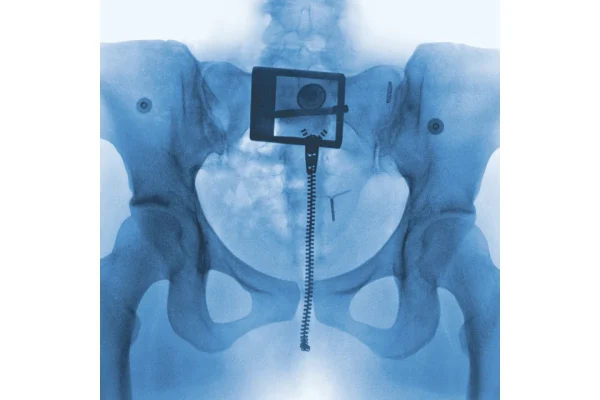Multiple threats close campus
By JESSE DUNSMORE
Senior Reporter
Empty.
It’s the simplest way to describe Oakland University on Monday, April 14, the day all classes were canceled, and the main campus was closed.
Normally filled to capacity, the lot in front of Vandenberg Hall held perhaps a fifth of that. Save for a couple news vans, the massive lot in front of the OC was a vacant desert of concrete. A lone vehicle on Meadowbrook Drive occasionally broke the stillness.
This was the silent aftermath of a series of threats taking the form of bathroom graffiti found in three men’s rooms around campus.
Though Oakland University Police Chief Samuel Lucido said the department hasn’t released — and says he won’t release — the specifics of the messages, they were threatening enough to close the campus, and for OUPD to encourage residents to go home until Tuesday morning.
A NEW DAY
“Today’s reopening has gone very well without incident. It’s just like any other day,” Lucido said Tuesday.
But that’s not true for everyone.
Interim Director of the Journalism Department Garry Gilbert is a graduate of OU. But when he held class on Tuesday, he locked the door — something he said he’s never done. “I’ve spent almost 20 years here. I feel safe here,” he said. “It insults me to a degree that something like this happened here.”
Gilbert said five or six students e-mailed him explaining they felt too nervous to come to class on Tuesday. “I told them I feel OU is safe,” said Gilbert, “but that I understood their anxiety and will see them Thursday.”
Political science professor David Dulio said he had great attendance in his classes today, but his Monday night class would have been the last session of that course for the semester, something Dulio calls a “tragedy.”
Though some students said they didn’t believe any real risk existed when the news broke — like freshman Curtis Glasper, who called the graffiti “a joke,” and sophomore Zakaya Montgomery, who called it “childish” — it still affected them. Glasper went home, and Montgomery planned to stay inside her room Monday.
“If there was a chance for something to happen, why would I risk it and stay here?” said sophomore Nicole Fortin, a pre-pharmacy major.
STAYING PUT, OR GETTING OUT
Some residents never left. Most of the roughly two dozen students who could be located for comment in East and West Vandenberg on Monday said they felt safe on campus.
“I’m not afraid of anything,” said sophomore Justin Hill. “Typically, threats don’t precede events like this. Usually they just happen.”
Sophomore biochemistry major Alex Castronova went home to Pinckney (a multiple-hour drive) for the weekend, and came back to discover the lockdown situation. “I’ve just got to stay here. I’m not going to spend the time going back.”
Hill, a business major, said he was an orientation group leader last summer, and that OU is statistically one of the safest campuses in Michigan. “The administration knows what they’re doing. The OUPD knows what they’re doing.”
Almost every student interviewed praised the university’s handling of the situation. “I think we’ll all be okay because they’re taking this so seriously,” said Elizabeth Miller, who learned about the situation online while in Toledo, Ohio for a lacrosse tournament before getting back Sunday evening.
However, some students saw room for improvement in the security measures.
The measures taken included ordering all guests in the residence halls to leave, FBI involvement, increased police patrols, 24-hour Nightwatch in the dorms, and a closed main campus.
“I’m not sure locking people in the dorms is such a good idea,” said sophomore Andrew Dickinson. “If anybody’s in the dorms, and they happen to be the crazy person … then you’re just sort of keeping them all stuck in one place.”
(Note: Students were not literally locked in the dorms, but were not permitted to wander campus.)
“I don’t know if I would have just stated it would be closed for one day, then open campus back up the next day,” said Derek Sokol, an electrical engineering major. He pointed out that Saint Xavier University in Chicago, which discovered similar messages on campus last week, was closed indefinitely.
TECHNOLOGY AT WORK
Without a doubt, technology played an integral part in alerting students to the situation at OU. Residents interviewed said that they learned of the situation via the mass e-mail alert sent to the entire student body, but also by voicemail sent to residents at their dorms, text messages and cellular phone calls from their friends, the post on OU’s Web site, or the television news.
Michelle Moser, OU’ assistant director of media relations said that the university is aware that students aren’t constantly checking their e-mail. “We needed to get people in classes and walking between classes.”
Beginning in the fall, students will have a more efficient way to receive vital emergency information and updates: text messages from OU.
In the event of an emergency on campus, said Lucido, students will be text-messaged with basic information and instructions to look online for more info. Updates would be supplied throughout the emergency, and when the situation is resolved.
Anyone with an OU e-mail account—including faculty and staff—will be able to sign up for the service by providing basic contact information on a Web page still under construction, Lucido said.
The service itself wouldn’t cost subscribers anything, though regular text messaging fees will apply.
When the service becomes available, the university will publicize it as much as possible, said Moser.
The system has been in development for months, said Lucido, and isn’t in response to any particular event. “We are evolving, getting bigger as a university, and we realized the need to increase the number of methods and the speed of emergency communication.”
“[The text system is the] quickest way possible to get out safety alerts to the greatest number of people possible,” said Lucido.
He also encouraged students to visit OU’s new emergency preparedness Web page, found via the “Emergency Info” link at the left of the main page. The preparedness page, originally launched March 27, includes procedures for a variety of emergencies, as well as other safety-related information.
On Tuesday, April 15, the Center for Student Activities launched a hotline to address any student concerns relating to the threats. The hotline, reachable at (248) 370-2400, will be open at least through this Friday, April 18.
Lucido said the hotline is there to respond to student concerns, but actual tips regarding suspicious or threatening behavior should be reported directly to OUPD.
SERIOUS CONSEQUENCES
If the author of the graffiti is apprehended, he or she could be facing considerably worse charges than vandalism.
“You’re talking about felonies, not misdemeanors,” said Ed Cibor of the Oakland County Prosecutor’s Office. According to Cibor, the perpetrator could potentially be charged under the terrorism statute.
“Making threats of violence is prohibited. …When you come into the public domain…you’re invading the peace of the public community, and you put in jeopardy the entire community,” said Cibor.
And although he said the specific penalties are up to the sentencing court, they could be severe. “You’re looking at a felony with a penalty of up to 20 years…or in excess, depending on the nature of the circumstances.”
“Individuals need to bear the brunt of their behavior.”
LOOKING AHEAD
Monday, as the sun dipped lower in the sky
, cars pulled up one or two at a time in front of the residence halls. Students got out with their backpacks or luggage. They entered their buildings, checked in with the 24-hour nightwatch posts, and moved back into their dorm rooms.
Even in the absence of bloody violence, some students said on Tuesday they felt affected by the threats alone — specifically, they felt more vigilant.
“I definitely think about those things more,” said Jillian Hepinstall, a freshman musical theater major, “and it makes me more sensitive to other people, because you never know what kind of life they’re having and what’s going to make them flip.”
Jeremy Drake, a sophomore communication major, agreed, saying, “When somebody goes for their pockets or wallets, I feel a little bit nervous. … But it just makes me pay more attention on campus.”
Students are handling the situation similarly to faculty whose classes were affected.
“We adapt,” said Dulio, “and roll with it.”
__________________
Kelly Kozlowski, Masudur Rahman, Jaclyn Rink, Amanda Saoud and Steve Staeger
updated 4/16/08 at 2:36 a.m.







